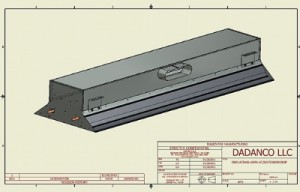
Removing Design Bottlenecks
By Scott Hale
CAD/CAM/CAE CAD design Imaginit Technologies InventorEliminating the relatively small but time-consuming steps that jam up the design process can result in huge productivity gains.
Caught in traffic, I can see the stalled car up ahead and think about how I am going to miss my first meeting of the day. A single car preventing hundreds of others from getting to work on time is a significant bottleneck, as well as a reason to think of how many of our clients have a single “car wreck” keeping them from being successful.
As design engineers, we try to solve efficiency problems. They are usually more complex than a traffic jam, and require more than a tow truck to resolve, but they usually start with locating the bottleneck. When I am troubleshooting manufacturing challenges, I apply a mental rule that has repeatedly proven true. While the general belief is that inefficiencies are hidden in all processes, in reality just 4 percent of the tasks an engineer performs can actually reduce productivity by 50 percent.

This Autodesk Inventor iLogic dialog box, developed by IMAGINiT Technologies, allows Dadanco engineers to configure an ACB 40 Unit in 3D using all of the design rules in effect for that product line.
The 4/50 Rule
I leverage the 4/50 rule regularly when solving customer issues. To illustrate, let’s take a look at a manufacturing business that has also been working to eliminate inefficiencies. Engineers at HVAC manufacturer, Dadanco, designed a patented induction technology to provide performance advantages in a wide range of HVAC products including active chilled beam, diffuser and induction units. These innovations allow MEP designers to specify custom, energy-efficient HVAC systems.
Dadanco products significantly reduce the amount of primary air required to cool a commercial building. The nature of the chilled beam systems is such that each zone often has unique product configurations. Even rooms of exactly the same size have different properties – depending on their position in the building and exposure to ambient heating from sunlight or another heat source.
Combining technology innovation and their unique customization approach allowed Dadanco to capitalize on a growing market opportunity and they increased their business by 300 percent in the first year of operation.
Normally, Growth is a Good Thing
To keep growing at that rate, however, the company needed to overcome a bottleneck in the design department. Customization is one of their biggest selling features and often puts them over the top in a bidding war. It also means more time per unit on the design side. With business growing at this pace, the company could simply not keep up with demand.
While many of Dadanco’s HVAC units have only a couple dozen or more components, describing a custom unit requires a full set of custom component and assembly drawings as well as a bill of materials (BOM) for production which is usually outsourced. On average, a set comprises 27 sheets and takes their designer two to three days to produce.
For some commercial buildings with more than thirty unit variations, that meant Dadanco was spending up to 60 days just on design. Engineering knew that they had to speed up the process for developing specification drawings but did not want to increase payroll by hiring more people.
Identifying the Bottleneck

Along with the 3D geometry, this drawing file is automatically created as a result of running the automation tools developed by IMAGINiT.
We began streamlining this repetitive process by creating a prototype template with predefined sheet configurations for Dadanco’s Active Chilled Beams product line—rebuilding each part and then tying them to assembly drawings. To support their customization process, our programmers used iLogic to create a dialogue-driven product configurator.
iLogic allowed us to implement rules-based design automation built on the experience and best practices of Dadanco’s engineering staff. By selecting a product template and providing some details, anyone can now generate a drawing set for a custom unit.
In addition, Engineers weren’t using their design assets effectively until we trained them on the benefits Autodesk Vault for proper drawing storage and version control. Now, instead of hunting for a “look-alike” unit and using it as a base drawing, designers can leverage the dialogue box interface to call up a product line template.
The automation tool then swaps out components as necessary, including mountings, the number of nozzles and coil configurations. Now, 90 percent or more of any drawing customizations required are completed automatically.
Templates Get Them Rolling Again
Removing the design bottleneck enabled Dadanco to create an entire set of shop drawings in 30 minutes instead of days. Now, they simply pull the right template and input a few details. This allows relatively few assembly templates to drive hundreds of different configurations. More importantly, the automation has allowed Dadanco to capture their years of expertise and bottle it so that practically anyone can design a custom unit.
Many companies grapple with how to ramp up production to meet demand without adding staff. To get started, I recommend making a list of those engineering tasks that are repetitive and time consuming, yet don’t contribute directly to the bottom line.
Almost always, people already know where the problems are because it feels just like being stuck in traffic. Removing the bottlenecks to productivity doesn’t have to be painful, and everyone loves flying down an empty highway.
www.dadanco.com
www.imaginit.com
Scott Hale is the Director Consulting Services, Manufacturing Services Division at IMAGINiT Technologies.
Click here to go back to the Manufacturing Leadership report on productivity.
